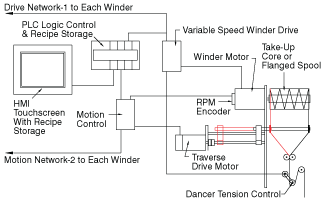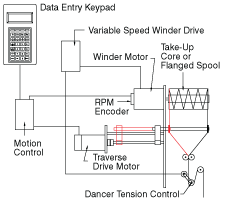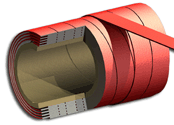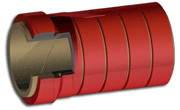Spool Rules
- Published: September 01, 2009, By By Bruce L. Butler, Independent Machine Co.
No longer just limited to paper, film, and foil materials, converting is a critical process for nonwovens and the increasing complexity of laminates. Integrated slitting and computerized traverse winding systems account for a growing segment of the converting industry.
Most narrow materials requiring exceptionally long lengths traditionally have been spooled to form a convenient package for handling, shipping, and unwinding. The finished spool size varies according to the needs of the next operation [unspooling] or the handling capability of the spooling operation.
Regardless of material or spool size, each traverse winding operation requires the “traverse” mechanism either to move the material back and forth laterally across the spool or to move the spool laterally back and forth under the fixed input of the material being spooled. For flexible materials such as wire, cables, threads, yarns, or extrusions that are round, moving the material across the spool is the standard spooling method because minimum product “twist” has little effect on product quality.
But for flat and profile materials that require consistent lay and cannot tolerate the stress caused by excessive guiding, moving the spool under the fixed input of the material often is preferable. This is especially true for wider, flat, tension-sensitive materials that operate in-line with a slitting, extrusion, or texturing operation application. The selection of the traverse type is an important first step in determining the complexity of the overall spooling system.
The accuracy of the traversing action — whether moving the material or moving the spool — and selection of the proper traverse pattern are much more critical to the spooling process for converted materials than tubular or round materials. This is the primary reason why traverse winding machinery developed for the wire and cable or textile industries is unsuitable in many instances for use in the converting industry, where flexible materials require careful attention to tension, winding patterns, and overall spool geometry.

In any case, the traverse position accuracy can be maintained only if it is directly linked to the rotational velocity of the winding spool. If tension is maintained through a proper closed loop tension feedback system, the rotational speed will decrease as the diameter of the spool grows. A computerized traverse utilizes “electronic gearing” to ensure the direct synchronization between winding spool and programmed traverse adjustment settings. An encoder provides a signal of the precise rotational spool position to the traverse controller, which maintains the preset winding pattern from core to full diameter regardless of winding speed changes.
A major advantage of a servo-driven traverse over many mechanical assemblies is the accuracy of the “electronic gearing,” which is not susceptible to overtravel as a result of speed changes during winding. This overtravel phenomenom most often is found in mechanical traverse units in which adjustment is made through a friction-type assembly.

Once the traverse type is determined, there are four basic traverse adjustments that are critical to overall spool quality for converted materials. When the traverse is computerized, each adjustment is extremely accurate and repeatable; it may be stored as a recipe for future use; and it may be password protected to stop unauthorized adjustments (see Figure 1 and Figure 2). Following are the four basic adjustments:
- Stroke Length | The precise linear distance of overall spool traverse (spool width)
- Pitch | The precise linear traverse movement per spool rotation
- End Dwell | The amount of rotational dwell at each traverse turnaround for edge stability (expressed in degrees)
- Traverse Pattern | Actual final spool shape
Typical traverse patterns include the following types:

- Level Wind | The turnaround ends of each layer are at the same point (see Figure 3)
- Taper Wind | Each traverse layer tapers a programmed amount from the edge to form a partial pyramidal shape (see Figure 4)
- Reverse Taper | Inverse of taper…requires specially shaped spools
- Index | Programmed stacked lanes with precise programmed index to the adjacent lane…also called Step Wind (see Figure 5)
- MagPak | Level Wind with Index wound edges for maximum edge stability without compromising product integrity

It is important to note that each pattern and all computerized adjustments are similar in either the material or spool movement traverse types.
Unlike round materials, flat (or converted) materials cannot rely on a simple width dimension for proper pitch setting. Many flat materials are traverse wound onto straight cores and not onto flanged spools and, therefore, cannot rely on trapping the material between the flanges. The flat material can be interlocked easily as it is spooled by overlapping the adjacent rotational lane, i.e., the amount of overlap (usually expressed in percentage) will determine the pitch setting. If a 1.0-in.-wide material is overlapped 25%, the pitch setting is 0.75 in. Conversely, the same material overlapped 75% has a pitch setting of 0.25 in.

Any change in pitch, which is actually a traverse distance per spool rotation, also must consider the stroke length or overall spool width. In a computerized traverse system, this is usually a calculation built into the traverse software. The stroke length is set, the pitch entered, and the software should be capable to determine automatically the number of traverse rotations to complete the stroke length requirement.
Once the pitch setting has been established, the end dwell is determined. This setting will fix the edge and will produce a flat spool across the face without an end node or concave appearance, either of which may cause problems in shipping or unwinding. The proper end dwell setting is a result of material flexibility, thickness, and pitch setting, and it usually is expressed in degrees.
A computerized traverse winding system works equally well with flanged spools or cylindrical cores and can be used with either. The cylindrical core also has the benefit of cost reduction (paper cores instead of more expensive flanged spools) and the ability to utilize a pneumatic lay-on roll to eliminate entrapped air and control roll density. Very often miles of material are traverse wound onto a single spool to feed the next operation without the need for splices and costly downtime.
The integrity of the spool created by proper control of tension and selection of spool settings will ensure the success of the converted material in the unwinding application. Ancillary equipment specially designed for unwinding spools under the same stringent tension parameters that created the spools now is available as a useful tool to complement the spooling process.
Bruce L. Butler is VP of Independent Machine Co., Fairfield, NJ. He has more than 30 years of experience supervising the design and construction of custom converting machinery and has been the team leader in the development of the computerized traverse, Smartwinders, for converting applications. Contact him at 973-882-0060; www.independentusa.com.
Supplier Info
-
Independent Machine Co. |www.independentusa.com
Circle 310 or visit www.freeproductinfo.net/pff
The views and opinions expressed in Technical Reports are those of the author(s), not those of the editors of PFFC. Please address comments to the author(s).




